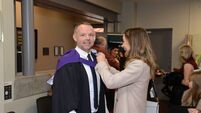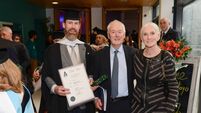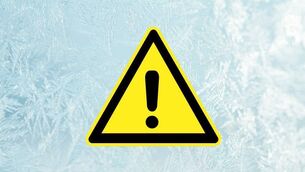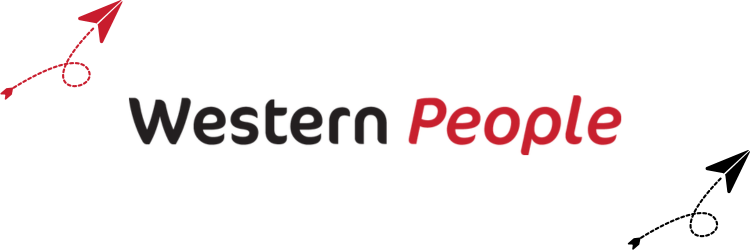Faith, renewal and the future of Knock Shrine
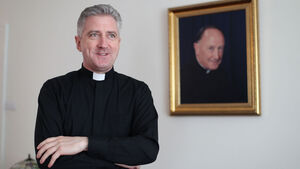
The rector of Knock Shrine Fr Richard Gibbons pictured in 2018 beside a portrait of his famous predecessor Monsignor James Horan. Picture: Niall Carson/PA Wire
Each August, the village of Knock becomes the spiritual heart of Ireland as tens of thousands make their way to the Marian Shrine for the annual Novena, a nine-day pilgrimage of prayer, reflection, and renewal. With its profound history, evolving approach to faith, and a clear-eyed view of contemporary challenges, the Novena is more than a tradition: it is a spiritual lifeline for many.
At the helm of this sacred event is Fr Richard Gibbons, Rector of Knock Shrine, who has overseen its growth and transformation in response to the changing spiritual and cultural landscape of Ireland.
Last week, the Western People was invited to the parochial house for an in-depth conversation with Fr Gibbons. The conversation took place in what was once the sitting room of Fr Gibbons' famous predecessor, Monsignor James Horan.
“That was his chair over there,” Fr Gibbons pointed out. “That’s where he sat when he was planning the Basilica and the airport and all the other developments you see around the place.”
For a second I could imagine Monsignor Horan sitting there, and wondered what his plan would be today. But we met to discuss the upcoming Novena and Fr Gibbons generously offered insights into the purpose and planning of the event, the challenges faced by the Shrine, and the hope he sees in its future.
“The Novena is nine days of prayer that you dedicate to a particular theme or a number of different types of themes,” Fr Gibbons explained. “It's a kind of a spiritual renewal for people during the course of the year.”
Far from being a rigid or repetitive religious exercise, the Novena is carefully curated each year to offer participants something new, grounding and relevant.
“We choose a theme the year before, and we focus on that theme and we break it down over the course of the nine days, with special speakers,” Fr Gibbons said. “Whether it's hope, or scripture, or the love of God, or a particular aspect of what's going on in life - you know, it could be the wars that are going on now at the moment and where does that sit in terms of material.”
In essence, Fr Gibbons said the Novena is designed as a chance for people to step back from the pressures of everyday life and reconnect with themselves, their community, and their faith.
“We choose these themes and the nine days, and it's just a period of time that people might like to dedicate to prayer and to kind of take themselves out of the madness of life and just kind of focus on their inner life and focus on God,” Fr Gibbons said. “It can be difficult sometimes to get the people we want, due to August being peak holiday time. A lot of planning goes into it.”
Fr Gibbons is well aware that not everyone who attends comes with unwavering faith.
“You don't have to be... you know, like most of us and most people are up and down in terms of the level of faith or in terms of their commitment,” he said. “They might be gung-ho at one particular time and not so much at another, but that doesn't stop you from coming. It kind of gives you a little bit of a kick-start again.”
Fr Gibbons says that people might pick and choose which speakers they want to hear.
“In the past, people would have attended the nine days or nights. Now they might say ‘I’m interested in that topic, so I’ll go that day,’ or they might attend a few days. And some still do come for the nine days, but a lot are selective, as to which days they will attend.”
The scale of the Novena is immense. Over nine days, Knock Shrine welcomes an estimated 150,000 visitors from across the country and beyond. Each day features two key events - Masses held at 3pm and 8pm - each with a guest speaker reflecting on that day’s aspect of the central theme.
“The Basilica holds roughly around 3,500 people, seated,” Fr Gibbons said. “But it was built to hold up to 10,000 people undercover, seated and standing. The people that will be at here, are from all over the country.”
At a recent Rosary Rally, the Basilica was packed.
“We had about 10,000 people in the Basilica that day. That's standing, and it was shoulder to shoulder. The seating and the layout is designed to accommodate crowds of that size.”
Managing such crowds requires not just physical space but also thoughtful programming. One of the recent innovations has been the introduction of workshops.
“If there's a particular topic being spoken about, ten minutes is fine for the input in the Mass but it's not enough if people are interested in the topic,” Fr Gibbons said. “So we've added workshops so the speakers can spend more time on the topic.”
These afternoon workshops, held at St John’s Welcome Centre, are not only well-attended but signal a shift in how Knock engages with the faithful.
“We hold the workshops at a quarter to one every day, and then at half past two we have the Anointing of the Sick,” he added. “People come from all over the country and beyond. We had a couple last year, for example, from Louisiana. They came because they followed us online during Covid.”
The Novena may be rooted in Irish soil, but its reach is global. In 2021, Knock was officially recognised by Pope Francis as an International Marian Shrine, a rare designation with deep symbolic and practical significance.
“There are officially about 1,600 national shrines in the Church,” Fr Gibbons added. “About 100 have international status. We deliberately went after that. It's the ultimate recognition. It’s kind of like the All-Ireland, if you like.”
The designation has elevated Knock’s status far beyond national borders.
“Knock is really the national shrine for the entire country,” Fr Gibbons said. “And now that it's got international status, it keeps it recognised at an international level as well.”
While many of those attending the Novena are older, Fr Gibbons has observed a growing diversity among pilgrims, particularly from Ireland’s immigrant communities.
“There are quite a number of young families coming not just for the Novena, but all year round,” he said. “We do get a lot of the Indians and Filipinos now that have come to live in the country, Brazilians, too, and those that would have a Catholic background of other nationalities.”
This multicultural presence is becoming a regular feature, not just at the Novena but at weekend Masses throughout the year.
“We would notice it's always an older group that do come,” said Fr Gibbons. “But we do have families that do come too. It ebbs and flows as well.”
Speakers can have a big impact on who turns up.
“We had Martin Morrissey, a number of years ago, and we had a huge gathering of young fellas from GAA clubs all over the country, on that occasion” Fr Gibbons said. “Marty comes here a lot privately. You’d see him at half-seven Mass.”
Like most religious institutions, Knock Shrine faced uncertainty in the wake of the Covid-19 pandemic. But instead of dwindling numbers, the Shrine has seen a remarkable resilience.
“We expected after Covid that there would be a big decline in numbers,” Fr Gibbons said. “But the overall numbers for the Shrine - it's hovering around a million people a year.”
Using laser counters on the gates, the Shrine is able to track footfall with relative accuracy. Last year saw a slight drop, but this year is showing positive signs.
“This year, at this particular juncture, we're up about 5% on last year,” Fr Gibbons said. “It has maintained very strong.”
Like every place, Knock is not without its challenges. Secularisation is an undeniable reality.
“There’s a kind of increased secularisation of the country,” Fr Gibbons said. “It’s a challenge to get some people interested in coming back again.”
Another concern is infrastructure.
“Some of the buildings here are quite old now. They're quite dated,” he acknowledged. “We’ve done a lot of refurbishment, but there are other aspects of the site that need to be upgraded.”
Fr Gibbons said that a comprehensive plan for development is now in motion.
“We’re looking at an overall plan for the Shrine,” he said. “It's a continuous evolution because we need to be a resource for the Church in Ireland.”
This is especially important as many retreat houses across the country close their doors due to a decline in vocations.
“Where are the people going to go? They come here,” he stated. “So we need the infrastructure and the development of pastoral renewal for the people here in Knock.”
To lead this renewal, a new Director of Pastoral Development has been appointed.
“The Director looks to see what we can put on here,” Fr Gibbons said. “What can we offer that will make somebody that sort of goes to church, or doesn't go to church, say ‘That's interesting. I’ll go to Knock, it's peaceful there.’”
Part of this vision includes connecting with people on the fringes of faith through culture and the arts.
“We developed one weekend on the interface between art and the Church and faith,” said Fr Gibbons. “We had artists come here and poets and musicians as well.”
One guest was Fr Patrick Van Der Vorst, a late vocation and former art expert at Sotheby’s in London.
“He brought that dimension of how beautiful paintings and famous works of art can say something to us, speak to us,” Fr Gibbons said. “It’s not overly religious, so you’re kind of connecting with people.”
The results have been encouraging.
“We had people there on that weekend that mightn't have set foot in a church for God knows how long,” he said. “But they came to that because they knew him, and because the topic interested them.”
The plan is to expand further.
“There’s lots of opportunities in the the grounds and in the gardens,” Fr Gibbons said. “We could have art installations, for example, and we will be looking at that.”
What is most important, he said, is that people are welcomed without pressure.
“You don’t say, ‘We have them here now, so they have to go to Mass,’” he explained. “You leave people alone. Let them get their own level. And if they feel that they're comfortable coming here, then they'll come back again.” This approach reflects a pastoral sensitivity.
“You preach the gospel where people are at, not where you’d like them to be,” Fr Gibbons said. “Let God do the work in that little space in between.”
Accessibility to Knock Shrine has improved thanks to infrastructure projects like the motorway to Galway and the link to Tuam, and the nearby Ireland West Airport.
“There’s a motorway basically from Dublin up to the west, and about 20 minutes out the road here we have the airport,” Fr Gibbons noted. “Accessibility is really good now. I am aware of a possible rail connection to the airport which is under discussion, and that could provide an additional boost.”
Digital access has also transformed the Shrine’s reach. Following the papal visit in 2018, Knock significantly upgraded its technology infrastructure.
“We set up a communications department specifically focused on getting the story out,” Fr Gibbons explained. “Whether it’s social media or whatever the case may be.”
The Shrine is active on all major platforms, and further digital developments are in the pipeline.
“We’re even developing our own app, and podcasts that people can tune into,” Fr Gibbons said. “We’ve embraced all of that and we hope to develop it further.”
As Fr Gibbons made clear, the Knock Novena is not simply a religious tradition clinging to relevance. It is a living, adaptive, and deeply human space; one that meets people where they are, gently guiding them toward something greater. Whether arriving on foot or tuning in from across the globe, pilgrims are offered a moment to pause, pray, and begin again.
As I leave the sitting room, I glance again at Monsignor Horan’s armchair. I think he'd be pleased that the facilities he developed are in safe hands.

